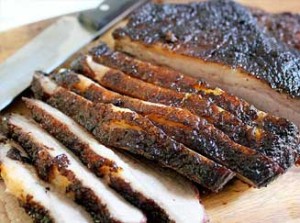It’s a festival of lights and we wanted to find a special recipe for BBQ grilling enthusiasts to prepare for their Hanukkah table. Here is fun and delicious smoked brisket recipe for that you can grill.
Happy Hanukkah from all of us at BBQ Repair Doctor!!!!
Hanukkah Style Smoked Brisket:
What You’ll Need:
1/4 cup kosher salt
2 tbsp freshly ground pepper
5 lb brisket flat
1) SEASON THE MEAT
An hour before preparing the grill, place brisket on a rimmed baking sheet. Mix salt and pepper in a small bowl and season the meat all over (it should look like sand stuck to wet skin but without being cakey). Let meat sit at room temperature for 1 hour.
2) PREPARE YOUR GRILL
For gas: Soak 6 cups wood chips in a bowl of water for at least 30 minutes or overnight. Leave in water throughout the cooking process. Keep remaining 2 cups chips dry. Light only 1 grill burner to medium [A] (if using a 3-burner grill, light burner on either end). Make sure drip tray [B] is empty, as a lot of fat will render. Place smoker box over the lit burner [C], add 1/2 cup soaked wood chips to box, and close grill. Adjust heat as needed to keep temperature at 225-250 degrees. We recommend using a stand-alone thermometer, even if your grill has one, to ensure an accurate reading. Stick it through the gap between the lid and base of the grill (or set it on the grill’s upper shelf, though this is not ideal, as it requires opening the lid more frequently). The wood chips should begin to smolder and release a steady stream of smoke [D]. How long this takes depends on how wet your chips are and the heat of your grill. To get more smoke without increasing grill heat, add a few dry chips to the soaked ones.
For charcoal: Fill chimney starter with charcoal; light and let burn until coals are covered with a thin layer of ash. Pour contents of chimney into one side of grill. Place 3 chunks of wood next to (not on top of) coals. (You want the wood to catch slowly and smolder. Placing them on top of the coals will cause them to burn too quickly.) Place grate on grill and cover grill, making sure to position vent on lid as far from heat source as possible. (This helps draw the smoke up and over the meat as it rises). Stick thermometer through top vent. Heat until thermometer registers 225-250 degrees, adjusting vents on bottom and top of grill as needed to maintain temperature.
For a smoker: Fill chimney starter with charcoal; light and let burn until coals are covered with a thin layer of ash. Pour contents of chimney into one side of grill. Place 3 chunks of wood next to (not on top of) coals. (You want the wood to catch slowly and smolder. Placing them on top of the coals will cause them to burn too quickly.) Place grate on grill and cover grill, making sure to position vent on lid as far from heat source as possible. (This helps draw the smoke up and over the meat as it rises). Stick thermometer through top vent. Heat until thermometer registers 225-250 degrees, adjusting vents on bottom and top of grill as needed to maintain temperature.
3) MAINTAIN THE HEAT
For gas: Place brisket, fatty side up, on grill grate as far away from lit burner as possible [E]. Cover grill and smoke meat, resisting the urge to open grill often, as this will cause the temperature to fluctuate. Adjust heat as needed to keep temperature steady at 225-250 degrees. Check wood chips every 45 minutes or so, and add soaked chips by 1/2-cupfuls as needed to keep smoke level constant.
For charcoal: Adjust vents as needed to control temperature. Check coals and hardwood about every 45 minutes. (Try to open lid as little as possible; check and replenish coals and hardwood at the same time.) For the coals, once you have checked them and decided to add more (they’ve burned down enough that you’ll need more to keep your fire going and maintain your grill temperature), fill a chimney halfway with coals, then add coals to grill once they’re covered with a thin layer of ash. (If you have a hinged grill grate, you can remove 1 lit coal from the grill with a pair of long tongs and place at the bottom of chimney to quickly light more coals.) If you control the heat well, you shouldn’t need more than 4-6 chimneyfuls of coals to cook the brisket (2-4 chimneyfuls if finishing brisket in the oven). When checking hardwood, move it around to a hotter spot if needed, or replenish extinguished chunks to keep level of smoking constant. Make sure to reposition top vent on lid over meat and away from heat source when replacing.
For a smoker: Adjust vents as needed to control temperature. Check coals and hardwood about every 45 minutes. (Try to open lid as little as possible; check and replenish coals and hardwood at the same time.) For the coals, once you have checked them and decided to add more (they’ve burned down enough that you’ll need more to keep your fire going and maintain your grill temperature), fill a chimney halfway with coals, then add coals to grill once they’re covered with a thin layer of ash. (If you have a hinged grill grate, you can remove 1 lit coal from the grill with a pair of long tongs and place at the bottom of chimney to quickly light more coals.) If you control the heat well, you shouldn’t need more than 4-6 chimneyfuls of coals to cook the brisket (2-4 chimneyfuls if finishing brisket in the oven). When checking hardwood, move it around to a hotter spot if needed, or replenish extinguished chunks to keep level of smoking constant. Make sure to reposition top vent on lid over meat and away from heat source when replacing.
4) KNOW WHEN IT’S DONE
For gas: Keep smoking the brisket, rotating every 3 hours and flipping as needed if top or bottom is coloring faster than the other, until meat is very tender but not falling apart and an instant-read thermometer inserted into the thickest part of meat registers 195-205 degrees, 10-12 hours total.
Need a cheat? If you just don’t want to spend your whole day at the grill, here’s a fail-safe, Aaron Franklin-endorsed alternate method that will deliver similarly glorious results: Smoke brisket on grill until an instant-read thermometer inserted into the thickest part of meat registers 150-170 degrees, 5-6 hours. Wrap brisket in foil, place on a baking sheet, and cook in a 250-degree oven until meat reaches the same 195-205 degrees internal temperature, 4-6 hours longer. What’s important is getting that smoky flavor into the meat, and 5-6 hours on the grill should do it. After that point, you’re simply getting the meat cooked through.
DO AHEAD: Brisket is best shortly off the grill, but you can still get good results smoking it up to 3 days ahead. Let cool for an hour before wrapping in foil and chilling. To serve, reheat meat, still wrapped, in a 325-degree oven until warmed through.
For charcoal: Keep smoking the brisket, rotating every 3 hours and flipping as needed if top or bottom is coloring faster than the other side, until meat is very tender but not falling apart and an instant-read thermometer inserted into the thickest part of meat registers 195-205 degrees, 10-12 hours total.
Need a cheat? If you just don’t want to spend your whole day at the grill, here’s a fail-safe Aaron Franklin-endorsed alternate method that will deliver similarly glorious results: Smoke brisket on grill until an instant-read thermometer inserted into the thickest part of meat registers 150-170 degrees, 5-6 hours. Wrap brisket in foil, place on a baking sheet, and cook in a 250-degree oven until meat reaches the same 195-205 degrees internal temperature, 4-6 hours longer. What’s important is getting that smoky flavor into the meat, and 5-6 hours on the grill should do it. After that point, you’re simply getting the meat cooked through.
DO AHEAD: Brisket is best shortly off the grill, but you can still get good results smoking it up to 3 days ahead. Let cool for an hour before wrapping in foil and chilling. To serve, reheat meat, still wrapped, in a 325-degree oven until warmed through.
For a smoker: Keep smoking the brisket, rotating every 3 hours and flipping as needed if top or bottom is coloring faster than the other side, until meat is very tender but not falling apart and an instant-read thermometer inserted into the thickest part of meat registers 195°-205°, 10-12 hours total.
Need a cheat? If you just don’t want to spend your whole day at the grill, here’s a fail-safe Aaron Franklin-endorsed alternate method that will deliver similarly glorious results: Smoke brisket on grill until an instant-read thermometer inserted into the thickest part of meat registers 150-170 degrees, 5-6 hours. Wrap brisket in foil, place on a baking sheet, and cook in a 250-degree oven until meat reaches the same 195-205 degrees internal temperature, 4-6 hours longer. What’s important is getting that smoky flavor into the meat, and 5-6 hours on the grill should do it. After that point, you’re simply getting the meat cooked through.
DO AHEAD: Brisket is best shortly off the grill, but you can still get good results smoking it up to 3 days ahead. Let cool for an hour before wrapping in foil and chilling. To serve, reheat meat, still wrapped, in a 325° oven until warmed through.




